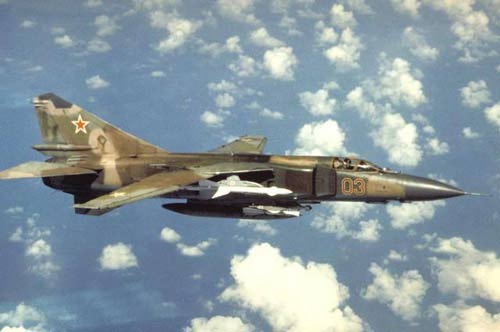Mikoyan-Gurevitch MiG-23 Flogger
Summary
| Category | Combat aircraft |
| Origin country | 🇨🇳 Ex-USSR |
| First flight | 10 June 1967 |
| Year of introduction | 1970 |
| Number produced | 5047 units |
| Average unit price | $4 million |
Description
The Mikoyan-Gurevich MiG-23, known as the "Flogger" in NATO reporting name, is a Soviet variable-geometry (swing-wing) jet fighter developed in the late 1960s. The MiG-23 was designed to offer better performance, range, and payload capabilities compared to its predecessors, such as the MiG-21.
Development of the MiG-23 began in the early 1960s, with the aim of creating a versatile jet fighter capable of adapting its wing configuration for optimal performance at different speeds and altitudes. The aircraft features a variable-geometry wing design, allowing the wings to sweep back for high-speed flight or extend for improved performance and maneuverability at low speeds. The first prototype of the MiG-23, designated 23-01, made its maiden flight in 1967.
The MiG-23 is powered by a single Tumansky R-29 turbojet engine, which provides substantial thrust for high-speed flight and rapid acceleration. Its design incorporates a sleek fuselage, forward air intake, and a bubble canopy for excellent visibility. The MiG-23's avionics suite includes radar, radio, and navigation systems, as well as an advanced fire control system for targeting and engaging enemy aircraft. The aircraft's armament typically consists of a 23 mm GSh-23L cannon and a variety of air-to-air and air-to-ground missiles, as well as unguided rockets and bombs for ground attack missions.
The MiG-23 entered service with the Soviet Air Force in 1970 and has participated in various conflicts, including the Soviet-Afghan War, Arab-Israeli conflicts, and the Iran-Iraq War. The MiG-23 has also been exported to numerous Soviet-aligned countries and served in several air forces around the world.
Several main versions of the MiG-23 have been produced, including:
- MiG-23S: The initial production variant, with limited avionics suite and basic armament.
- MiG-23M (Flogger B): A major production version with an improved radar system, upgraded avionics, and enhanced weapon-carrying capabilities.
- MiG-23MF (Flogger B): An export variant of the MiG-23M, with downgraded avionics suite.
- MiG-23ML (Flogger G): A further development with a lighter airframe, improved aerodynamics, and an upgraded engine.
In total, over 5,800 MiG-23 aircraft have been built, making it one of the most produced variable-geometry jet fighters in history.
Technical specifications
| Version: MiG-23ML Flogger-G | |
|---|---|
| Crew | 1 pilot |
| Operational range | 1150 km (715 mi) |
| Maximum speed | 2500 km/h (1553 mph) |
| Wing area | 37 m² (398.3 sqft) |
| Wingspan | 14.0 m (45.8 ft) |
| Height | 4.8 m (15.8 ft) |
| Length | 16.7 m (54.8 ft) |
| Service ceiling | 18000 m (59055 ft) |
| Empty weight | 10230 kg (22553 lbs) |
| Max. takeoff weight | 17800 kg (39242 lbs) |
| Climb rate | 240.0 m/s (787.4 ft/s) |
| Takeoff distance | 450 m (1476 ft) |
| Powerplant | 1 × turbofan Tumansky R-35F-300 delivering 12996 kgp |
Current operating countries
| Country | Units | ||
|---|---|---|---|
|
|
Syria | 87 | |
|
|
North Korea | 56 | |
|
|
Cuba | 24 | |
|
|
Angola | 22 | |
|
|
Ethiopia | 9 | |
|
|
Libya | 4 | |
|
|
Kazakhstan | 3 | |
|
|
Sudan | 3 | |
|
|
Zimbabwe | 3 | |
| 🇨🇩 | Congo Democratic Republic | 2 | |
Numbers in parentheses, e.g. '(+5)', indicate units ordered but not yet delivered.
All operators
Afghanistan • Angola • Bulgaria • Belarus • Congo Democratic Republic • Cuba • Czech Republic • Ex-East Germany • Algeria • Egypt • Eritrea • Ethiopia • Hungary • India • Iran • Iraq • Israel • Kazakhstan • Libya • Poland • North Korea • Romania • Russia • Sudan • Syria • Ex-Czechoslovakia • Turkmenistan • Ukraine • Ex-USSR • United States • Yemen • Zimbabwe
Armament
Missiles payload:
Photo of MiG-23 Flogger

3-view profile
